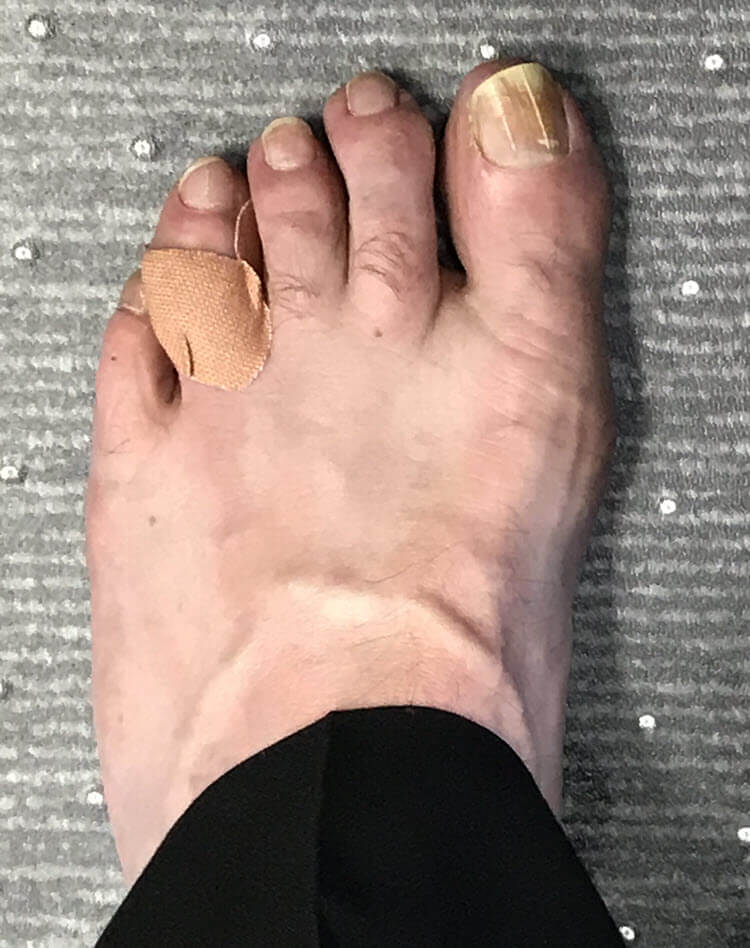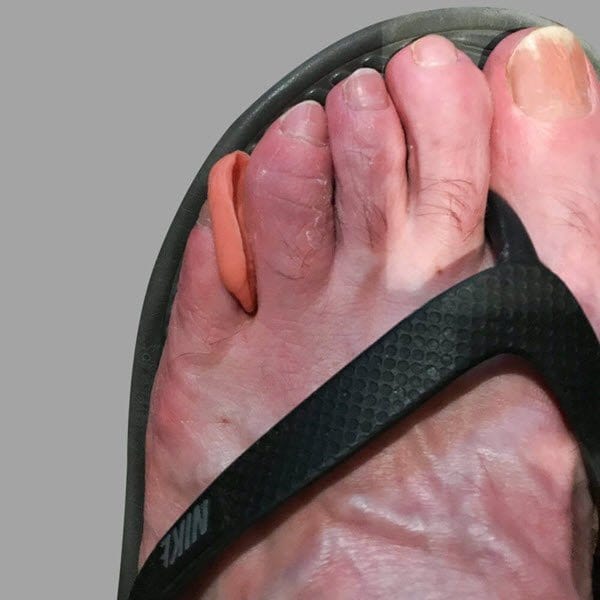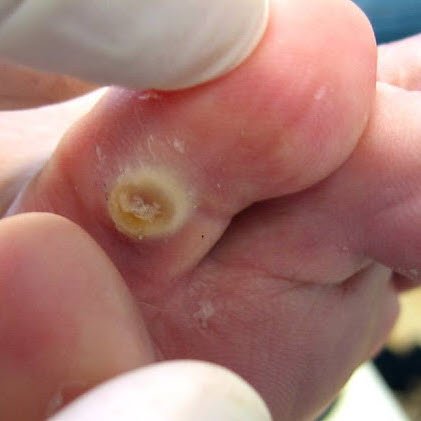Following my last post about corns, Ashley is a runner who's suffering with a painful corn between toes 4 and 5. This interdigital corn developed for the first time 12 months ago. He feels he's done all he can to prevent it from recurring, to no avail. At this point, he's wondering what more he could have done to stop it from coming back.
Hi Rebecca. I’m after some advice. I’ve used a number of blister products over the years. I’ve also done your blister course which was very helpful for me as an ultrarunner, and I refer to it often. But I have a big problem on my fourth toe (between it and the little toe) that I hope you can help me with.
I had a corn on this toe 12 months ago which got infected and now there’s some scar tissue. For the last 12 months I have worn a gel toe spacer with most shoes; at work, and every time I run. But in last week this toe has become so painful again. The spacer isn’t helping any more as it seems to just add more pressure. It's really effecting my ultrarunning training. I have tried silicone spacers, gel sleeves, cottonwool, but as soon as there is any pressure on this area, it really hurts! Yesterday it reached the most painful of all.
The weekend's activities
This weekend I set off on a 4.5 hour run. It was noticeable before I set off and within the first 40 minutes, I went from cottonwool between the toes, to a gel toe sleeve, and back again to the cottonwool. But we had a river crossing at one hour and my feet got wet and the next 3.5 hours it got progressively worse. Especially when returning from an 800m vertical climb - coming downhill was really unpleasant.
On Sunday I ran another 2 hours. I used pawpaw cream and cottonwool to try and get me through and keep my feet dry. But it was a really tough 120 minutes. That’s where I am now. I've booked in to see my local Podiatrist this afternoon
Ashley isn't expecting miracles
I don't expect miracles, but just want to understand why this corn between toes problem is ongoing and why I can't seem to shake it. I can’t seem to find a toe spacer that helps. My local podiatrist is really good, but I'm the only ultrarunner she deals with, so I was just wanting to reach out to see if you have seen such a thing in your experience with ultrarunners.
A quick update on the corn after the podiatry visit
As I suspected, my corn was infected. My podiatrist treated it yesterday, I got antibiotics from my GP and I’m redressing every 2 days. It already feels 150% better than Saturday or Sunday.
I’m just curious though, why did this happen again, even though I’d been wearing a silicone spacer just about every time I put shoes on for the last 12 months. In fact, in the last few weeks, the gel spacer made it feel worse. It felt like it was adding pressure. No doubt this infection will heal and everything will feel much better again soon. But it seems I’ll be back to the drawing board on trying to find a spacer that prevents this from happening again.
A little more on the history of Ashley's infected corn between toes
Ashley indicated that the corn he got 12 months ago was the first time he’d ever had a corn. Since then, he hadn’t had any treatment for it. But very smartly, he'd used his gel toe spacer every day in an attempt to prevent it from happening again. That’s why he's so perplexed that this corn has redeveloped, and become infected again.
I was curious about dermatological, circulatory or any other medical conditions and drew a negative on those, which is a good thing. I was curious because, one doesn't usually get scar tissue from corns. And in my 25+ years as a podiatrist, I can safely say that 99% of corns between the toes don’t get infected.
Unfortunately, we couldn’t get an in-focus photo of Ashley’s corn. But the bandaid in this photo shows where the corn is – on the outer side of the fourth toe.

Ashley's infected corn is on the outer side of the 4th toe, in the 4/5 interdigital space. This photo was taken not long before visiting his podiatrist.
Here’s my take on Ashley’s corn situation
To be clear, no amount of cushioning was going to make Ashley’s toe feel better once it was infected. The infection needed to be addressed.
Similarly, the thick skin needed to be debrided before it can feel better. Ashley did the right thing by wearing something between his toes every day. When it comes to corns (and callouses), you don’t want to leave it until you have a corn before you wear something to protect it. The horse has bolted by then. The idea is to slow down the rate of development, which requires wearing the device from the day you have the corn treated by the podiatrist.
So Ashley did really well by wearing his toe spacer just about all the time. However, the reality is, there would have been times when he was without it and the skin was having to react to the pressure. For example, taking your shoes off after work, going barefoot on a hot day, all the steps you take in the morning before putting your shoes on, and the odd day you actually don’t wear it.
Protective response
When there’s too much pressure or shear imparted to the skin, it lays down more skin as a kind of protective response. Plus, the gel cushioning will lose its effectiveness as it degrades with repeated wear, especially from the toenail of the little toe that tucks in under that 4th toe (picture above). And that’s to mention nothing of the heavy workload Ashley’s feet are subjected to with his running.
Corns recur!
The fact is, corns and callouses recur. They tend to come back because there’s usually a structural reason why they’re there in the first place. That structural cause is usually difficult to deal with, day in day out, in a way that nullifies it altogether.
So when it comes to corns and callouses, the key is to have realistic expectations. Okay, you might get really lucky and the corn was a one-off, never to return again. But more often than not, the cause is still there (curly toe, clawed toe, shape of adjacent toe, nail deformity, bunion, shoe-fit issue) and it comes back. So, it is reasonable to EXPECT corns to recur, in spite of your best efforts to prevent it. Sure, we can do things to try and slow them down. But when they start to get sore again, you need to see your podiatrist again and get it dug out (enucleated).
Eleven months without corn pain is a good result!
I can see people every 6-8 weeks for corn enucleation – and that’s with some form of pressure management strategy in place. So, to have gone 12 months (well let’s say 11 months) without any pain from that corn between the toes – that’s a great outcome in my book.
In Ashley’s case, a trip to the podiatrist once a year, plus wearing a protector between his toes every day - that's an appropriate plan. I wouldn’t be disappointed with that.
But let’s say Ashley wasn’t happy with having to see his podiatrist every year. Was there anything else he could do? Is there anything better than a gel toe wedge?
Is there anything better than a gel wedge for a painful corn between the toes?
Yes there is!
The gel toe protectors can be great for helping to prevent corns and callouses on the toes. They reduce a lot of the forces that lead to this kind of hyperkeratosis. Certainly, the gels are better than foams. But there’s something even better than the gels at reducing pressure. And that’s, Otoform K toe devices.
What is Otoform K?
Otoform K is a putty that podiatrists use to make custom-moulded devices to be worn on the toes. For example, they can be made to lift the shoe off a corn on a hammertoe. Or as a toe-prop to make a clawed toe sit straighter to reduce the weightbearing pressure on the tip of the toe - watch the video below as I demonstrate. And they’re great for corns between toes!
Interdigital corns develop where a prominent bone from one toe presses on a prominent bone on the adjacent toe. So instead of there being an even pressure along the whole interdigital space, there’s a concentration of pressure at this bone-on-bone point. That’s what causes the corn.
Otoform K is placed between the toes and while standing, the putty sets to the shape of that interdigital space. Once set, it’s still bendy, but it holds its shape. If you hold your new wedge up to the light, you’ll see it’s very thin where the corn is, and thicker elsewhere.
In this way, when wearing the custom-made wedge, the pressure is evened out over the whole interdigital space. No more concentration of pressure.
This is a better method of reducing pressure than gel toe protectors. Sure, the gels cushion and absorb shear tremendously. And they’re almost always comfortable. But the Otoform K wedges can reduce pressure more effectively. That’s the most important thing with corns – reducing pressure as opposed to friction levels or absorbing shear.

Ashley's Otoform K interdigital wedge
What more could Ashley have done about his corn between toes 4 & 5?
Firstly, understand that it will come back again.
Secondly, try an Otoform K toe wedge.
Thirdly, even if he sticks with the gel protector, understand that a year without corn trouble is a great result, especially for someone so active. Just see a podiatrist at the first sign of a niggle. There’s no point trying to tough it out – it’s going to get worse. The corn between toes will either ulcerate or get infected or just get so damned painful and need more treatment than if you’d sought attention early on.
To my delight, Ashley said his podiatrist discussed the Otoform K custom-made interdigital wedge at his last appointment and together they will try this once the infection has resolved, the wound has healed and the swelling has gone down.








